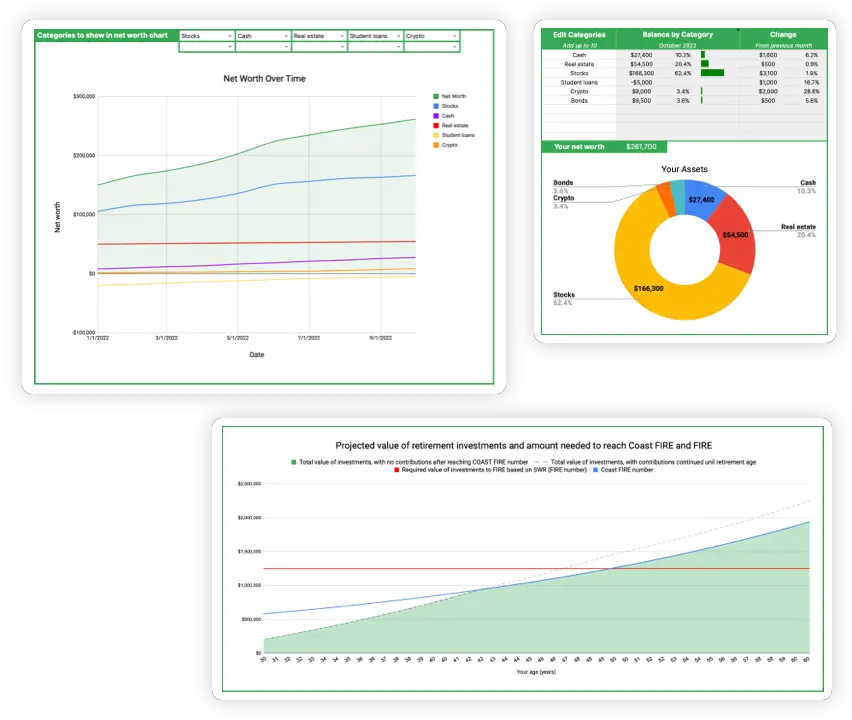Discover how much you can save by switching to a Tesla electric vehicle (EV)
Take your wealth planning to the next level with my Wealth Planning Toolkit for Google Sheets – just $20.
Plan for recurring monthly income over different time periods as well as windfalls and one-time purchases in the future.
Includes 10 year Net Worth Tracker with Dashboard, Asset Rebalancing Calculator, and advanced FIRE and Coast FIRE Calculators.

With their sleek looks, impressive safety, advanced battery technology and leading charging infrastructure, Tesla electric vehicles (EVs) have dominated the EV scene in recent years, with the brand owning about 20% of global EV market share in 2023. While Tesla EVs are not only fun to drive, they can also help you save a bunch of cash on fuel costs, especially for commuters. Depending on your personal driving situation, a Tesla may pay for itself faster than you would think when compared to an equivalent gasoline vehicle.
Using this calculator
This calculator is intended to help you understand how much you could save by going with a Tesla electric vehicle the next time you are looking to purchase a new ride.
Simply adjust the inputs above and then your annual savings, purchase break even point, and average cost per charge will be automatically calculated!
- Miles driven per year is your average expected driving mileage per year. According to the U.S. Department of Transportation’s Federal Highway Administration, the average American drives around 13,500 miles every year.
- Local gas price can vary widely by city and state. GasBuddy.com is a great resource for finding the best gas price in your area. The average gas price in the USA in 2023 was around $3.52 per gallon
- Local electricity rate is the rate in dollars per kiloWatt hour (kWh) that you pay for electricity to charge your Tesla EV.
- How often will you use free charging? Adjust this slider to factor in any opportunities for free EV charging that you would plan to take advantage of with your Tesla. For example, you may be able to charge your Tesla for free at your workplace or find free public charging stations using PlugShare.com. Selecting 100% means that you are using all free charging and never charging at home.
- Battery capacity is the full charging capacity of your Tesla model in kiloWatt hours (kWh).
- Range is the distance your Tesla model can travel on a full battery charge.
- Purchase price is the all-in purchase price of your Tesla after factoring in any tax credits that you may be eligible for. Check out FuelEconomy.gov to see what tax credits you may qualify for with your Tesla purchase.
- Average gas mileage is the fuel efficiency in miles per gallon (MPG) of a comparable gas vehicle.
- Gas vehicle purchase price is the all-in purchase price of a comparable gas vehicle.
Here’s how to interpret the results:
- Break even point is how long it takes for the fuel savings from your electric vehicle to make up for the difference in price between an electric vehicle and an equivalent gas vehicle. For example, if your break even point is 4 years, then after 4 years you will have “broken even” on your EV purchase meaning that your savings on fuel have already paid for the difference in purchase price. The lower your break even point, the better. Since the average driver keeps a new car for 6 years, you should aim to have a break even point that is less than 6 years.
- Annual electricity cost is the yearly cost of electricity to charge your Tesla EV.
- Annual gas cost is the yearly cost of fuel to drive your gasoline vehicle.
- Annual Tesla savings is the yearly fuel cost savings that you would experience by driving an Tesla EV rather than a gas vehicle. Your annual Tesla savings = annual gas cost – annual electricity cost.
- Tesla effective MPG based on energy costs is the distance traveled by your Tesla when spending the cost of one gallon of gas on electricity.
- Tesla average cost per charge is the average cost for each complete charge of your Tesla’s battery.
Advantages of Tesla electric vehicles
- They are simply more fun to drive. One unique quality of EVs in general is that they produce instant peak torque, which means that you have maximum acceleration and power the moment you step on the gas pedal. This translates to a level of responsiveness and smoothness in daily driving that gas cars simply cannot match. Joe Rogan stated it elegantly: “I think a Tesla is the most fun thing you could possibly ever buy.”
- Lower fuel costs compared to gasoline vehicles. As you can see in this calculator, Tesla EVs can offer impressive savings on fuel, especially if you are a commuter and have access to free charging at work .
- Lower maintenance costs and less frequent maintenance. Since they don’t have a gas engine, Teslas do not require oil changes or any of the other maintenance/repairs associated with traditional gas engines. Teslas also use regenerative braking, so there is less wear on your brakes, which leads to fewer brake replacements.
- Carpool (HOV) lane access. In some states like California, driving a Tesla EV can enable you to drive in a Carpool lane (aka High Occupancy Vehicle / HOV) even when you are driving by yourself. Since traffic can often move much faster in the HOV lane during rush hour, this is a coveted benefit that can save you valuable time over the ownership of your Tesla.
Downsides of Tesla electric vehicles
- Shorter range than gas vehicles. In general, Teslas can travel a shorter distance on a full charge compared to a similar gas vehicle on a full tank of gas. For example, the base model Tesla Model 3 offers up to 341 miles of driving range, while a base model Toyota Corolla can go about 435 miles on a full tank.
- Recharging the battery takes time. Depending on your power source, it can take several hours to charge your Tesla’s battery while filling up your gas tank takes just a few minutes. On the fast side, Tesla’s V3 Supercharger can fill a Tesla Model 3 to 80% full in 15 to 20 minutes. However if you are charging with a standard 120V home power outlet, it could take 3 to 4 days to fully charge a depleted battery.
- Having to plan around charging infrastructure. While Tesla’s Supercharger network is the largest EV fast-charging network in the world with over 50,000 Superchargers as of 2024, charging infrastructure is still limited in many parts of the country. This means driving a Tesla can introduce headaches when planning a roadtrip and could limit the routes you can travel. When you consider the point above about the time it takes to recharge the battery, you may find that an EV is not ideal for roadtrips in certain parts of the country.
- Higher upfront price than gasoline cars. When you start shopping around for a Tesla, you may note that they require a higher upfront purchase compared to a similar gas vehicle. Depending on your annual driving mileage, the break even point for switching to a Tesla may be longer than you plan to keep the car, so it wouldn’t make financial sense.

